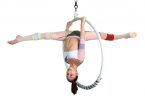Incontinence can be a challenge for pole dancers, but with the right strategies, it’s possible to manage this issue effectively while continuing to enjoy the physical and emotional benefits of pole fitness. In this guide, we’ll explore incontinence management for pole dancers, focusing on pelvic floor health, core strengthening, and lifestyle changes that will allow you to maintain your passion with confidence.
In recent years, the dialogue surrounding pelvic floor health has gained significant momentum, highlighting its indispensable role in overall well-being and the effective management of incontinence. Incontinence can pose unique challenges for pole dancers, whose activities demand exceptional physical strength, flexibility, and core engagement.
However, with the right strategies, it’s entirely possible to manage these challenges effectively. This guide offers a holistic approach to incontinence management tailored for pole dancers, emphasizing pelvic floor health, core strengthening, and lifestyle adjustments to ensure you can continue to pursue your passion with confidence and security.
Protecting Pelvic Health in Pole Fitness
Pole fitness, commonly perceived as merely an art form or a regimen for boosting strength and flexibility, also plays a pivotal role in engaging and strengthening the core and pelvic floor muscles. This aspect is especially important, as it highlights the discipline’s contribution to physical health beyond its aesthetic and fitness benefits.
Despite the rigorous physical conditioning that pole fitness provides, which includes significant work on the pelvic floor and core muscles, dancers are not immune to experiencing incontinence issues.
Incontinence among pole dancers can arise from various factors, including the high-impact nature of certain moves that put pressure on the pelvic floor, pre-existing weaknesses in the pelvic muscles, or even the strain of repetitive movements over time. This juxtaposition of pole fitness as both a strengthener of the pelvic region and a potential stressor underscores the need for a balanced and informed approach to training.
Dancers facing incontinence issues benefit from incorporating specific pelvic floor exercises into their routine, adjusting their practice to include more low-impact movements, and being mindful of their body’s signals.
Understanding and addressing incontinence within the context of pole fitness requires a nuanced appreciation of the body’s mechanics, as well as a commitment to holistic health that encompasses both the empowering aspects of pole dancing and the management of physical challenges such as incontinence.
Incontinence Management Tips for Pole Dancers/Athletes
Incontinence can be a challenging issue for pole dancers and athletes, given the physical demands and core engagement required by their activities. However, with the right management strategies, individuals can continue to pursue pole dancing while effectively managing incontinence symptoms.
Here are some targeted tips for incontinence management tailored for pole athletes:
1. Understanding Your Body
- Identify Triggers: Recognize activities or movements in pole dancing that exacerbate incontinence symptoms. This awareness can help in adapting routines or focusing on specific management strategies.
- Types of Incontinence: Understand whether you’re dealing with stress incontinence, urge incontinence, or a combination of both, as this will influence the management approach.
2. Strengthen the Pelvic Floor Muscles
- Incorporate pelvic floor exercises (also known as Kegel exercises) and pelvic massages into your daily routine to strengthen these muscles. Strong pelvic floor muscles provide better support for the bladder and urethra, reducing leakage.
- Consider consulting a pelvic floor therapist who can provide personalized exercises and feedback on technique, ensuring you’re effectively targeting the right muscles.
3. Core Strengthening
- Incorporate Core Workouts: Engage in exercises that strengthen your core muscles, including your lower back, hips, and abdomen. A strong core supports your pelvic floor and can help manage incontinence.
- Pilates and Yoga: These disciplines focus on core strength, flexibility, and breathing, all of which can benefit pelvic floor health.
4. Wear Appropriate Gear
- Consider wearing absorbent pads or specialized women’s protective undergarments designed for athletes with incontinence during practice or performances. These can provide security and absorb any potential leakage.
- Choose attire that supports your movements without adding undue pressure on your abdomen or pelvic area.
5. Hydrate Wisely
- Stay hydrated, but be mindful of your fluid intake, especially before performing. Excessive fluid intake can exacerbate incontinence symptoms.
- Reduce consumption of bladder irritants like caffeine, alcohol, and acidic beverages, which can increase the urge to urinate.
6. Manage Diet and Weight
- Excess weight can put additional pressure on your pelvic floor muscles. Maintaining a healthy weight through balanced nutrition and regular exercise can alleviate some of this pressure.
- A diet high in fiber can prevent constipation, which can put a strain on the pelvic floor.
7. Plan Your Routine
- Pre-Exercise Routine: Empty your bladder before starting your pole dancing session. This can help minimize the risk of leakage during physical activity.
- Incorporate brief breaks into your training sessions to use the bathroom, reducing the likelihood of accidents.
8. Breathing Techniques
- Practice diaphragmatic breathing, which can help manage intra-abdominal pressure during intense pole maneuvers. Proper breathing ensures that you’re not inadvertently increasing pressure on your pelvic floor.
9. Practice and Performance Strategies
- Preparation: Empty your bladder before practice or performances. Using protective pads or specialized garments can provide peace of mind.
- Adaptation: Modify your training routine to avoid moves that trigger your symptoms, focusing instead on those that strengthen the pelvic floor.
- Breathing Techniques: Implement deep breathing techniques to control abdominal pressure during intense routines, protecting the pelvic floor.
10. Seek Support and Advice
- If incontinence affects your pole dancing or daily life, seek advice from healthcare professionals who can offer tailored advice and treatment options.
- Engage with the pole dancing community. Many athletes share similar experiences and can offer support, advice, and encouragement.
Final Thoughts
Managing incontinence as a pole dancer requires attention to both physical and emotional well-being. By implementing these strategies, you can continue to enjoy pole dancing, pursuing your passion with confidence and strength. Remember, what works can vary from person to person; stay open to adjusting your approach as you discover what best supports your body and performance.
While pole fitness offers numerous benefits, individuals with severe pelvic floor dysfunction must proceed with caution. Consulting with a healthcare provider before embarking on a pole fitness journey is advisable to tailor the exercise regimen to individual needs and avoid exacerbating any existing conditions.








